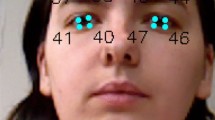Abstract
Many researchers in the Human Robot Interaction (HRI) and Embodied Conversational Agents (ECA) domains try to build robots and agents that exhibit human-like behavior in real-world close encounter situations. One major requirement for comparing such robots and agents is to have an objective quantitative metric for measuring naturalness in various kinds of interactions. Some researchers have already suggested techniques for measuring stress level, awareness etc using physiological signals like Galvanic Skin Response (GSR) and Blood Volume Pulse (BVP). One problem of available techniques is that they are only tested with extreme situations and cannot according to the analysis provided in this paper distinguish the response of human subjects in natural interaction situations. One other problem of the available techniques is that most of them require calibration and some times ad-hoc adjustment for every subject. This paper explores the usefulness of various kinds of physiological signals and statistics in distinguishing natural and unnatural partner behavior in a close encounter situation. The paper also explores the usefulness of these statistics in various time slots of the interaction. Based on this analysis a regressor was designed to measure naturalness in close encounter situations and was evaluated using human-human and human-robot interactions and shown to achieve statistically significant distinction between natural and unnatural situations.
Similar content being viewed by others
References
Mohammad Y, Xu Y, Matsumura K, Nishida T (2008) The h 3 r explanation corpus:human-human and base human-robot interaction dataset. In: The fourth international conference on intelligent sensors, sensor networks and information processing (ISSNIP2008)
Qazi Z, Wang Z, Haq I (2006) Human likeness of humanoid robots exploring the uncanny valley. In: International conference on emerging technologies, ICET’06, pp 650–656
Shi Y, Choi EHC, Ruiz N, Chen F, Taib R (2007) Galvanic skin respons (gsr) as an index of cognitive load. In: CHI 2007, pp 2651–2656
Mandryk RL, Inkpen KM (2004) Physiological indicators for the evaluation of co-located collaborative play. In: CSCW’04
Lin T, Hu W, Omata M, Imamiya A (2005) Do physiological data relate to traditional usability indexes? In: OZCHI 2005
Lang PJ (1995) The emotion probe: studies of motivation and attention. Am Psychologiest 50(5):372–285
Mower E, Feil-Seifer DJ, Mataric MJ, Narayanan S (2007) Investigating implicit cues for user state estimation in human-robot interaction using physiological measurements. In: 16th international conference on robot & human interactive communication, pp 1125–1130
Bradley MPL (2000) Measuring emotions: behavior, feeling and physiology. In: Cognitive neuroscience of emotion. Oxford University Press, New York
Argyle M (2001) Bodily Communication, new edn. Routledge, London
Mohammad Y, Nishida T (2007) TalkBack: Feedback from a miniature robot. In: AI 2007: Advances in artificial intelligence, 20th Australian joint conference on artificial intelligence, Gold Coast, Australia, December 2007, pp 357–366
Papillo JF, Shapiro D (1990) The cardiovascular system. In: Principles of psychophysiology: physical, social, and inferential elements. Cambridge University Press, Cambridge
Rowe DW, Sibert J, Irwin D (1998) Heart rate variability: indicator of user states an aid to human-computer interaction. In: Conference on human factors in computing systems (CHI98)
Kidd CD, Breazeal C (2005) Human-robot interaction experiments: lessons learned. In: Robot companions: hard problems and open challenges in robot human interaction symposioum of social intelligence and interaction in animals robots and agents, pp 141–142
Safavian SR, Landgrebe D (1991) A survey of decision tree classifier methodology. IEEE Trans Syst Man Cybern 21(3):660–674
Steinwart I, Christmann A (2008) Support vector machines. Springer, Berlin
Rosner B (1975) On the detection of many outliers. Technometrics 17(2):221–227
Mohammad Y, Nishdia T (2008) Human adaptation to a miniature robot: Precursors of mutual adaptation. In: IEEE 17th international symposium on robot and human interactive communication (IEEE Ro-Man), pp 124–129
Liao W, Zhang W, Zhu Z, Ji O (2005) A decision theoretic model for stress recognition and user assistance. In: AAAI 2005, pp 529–534
Stern RM, Ray WJ, Quigley KS (2001) Psychological recording, 2nd edn. Oxford University Press, Oxford
Mohammad Y, Nishida T (2009) Robust singular spectrum transform. In: IEA/AIE, pp 123–132
Mohammad Y, Nishida T (2009) Measuring naturalness during close encounters using physiological signal processing. In: IEA/AIE, pp 281–290
Author information
Authors and Affiliations
Corresponding author
Rights and permissions
About this article
Cite this article
Mohammad, Y., Nishida, T. Using physiological signals to detect natural interactive behavior. Appl Intell 33, 79–92 (2010). https://doi.org/10.1007/s10489-010-0241-4
Published:
Issue Date:
DOI: https://doi.org/10.1007/s10489-010-0241-4




